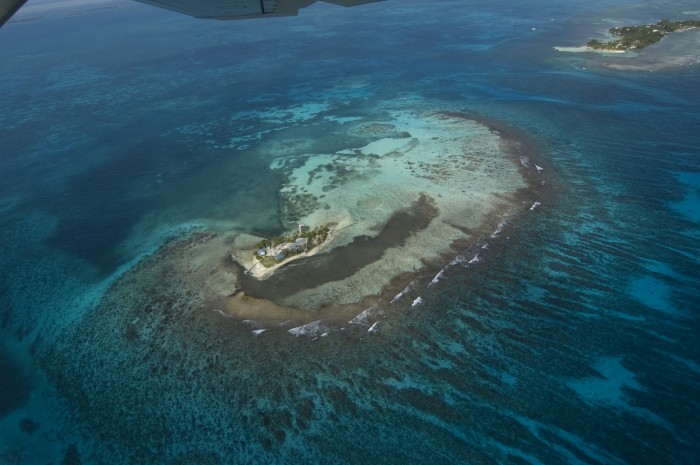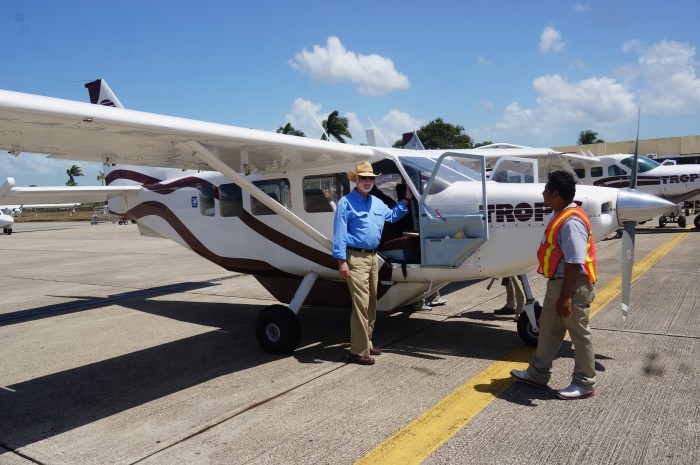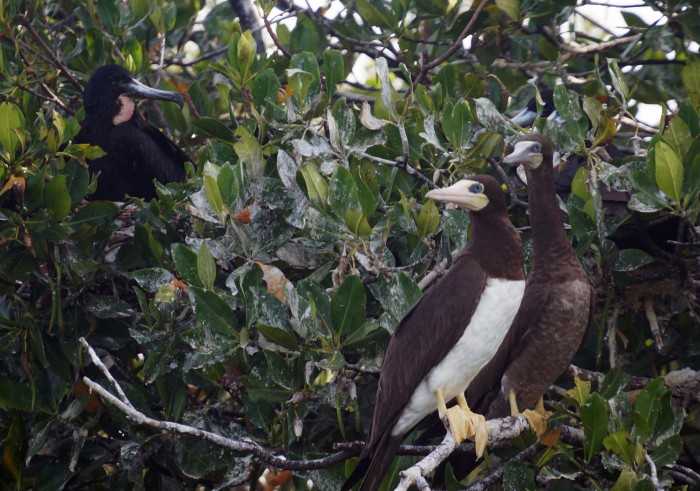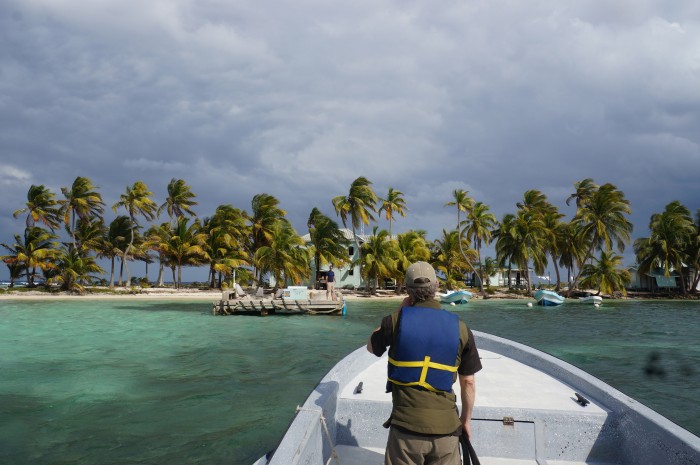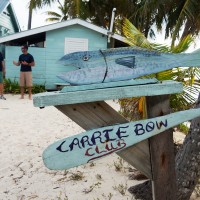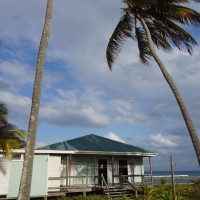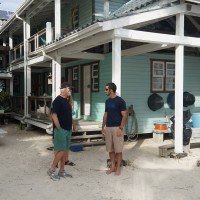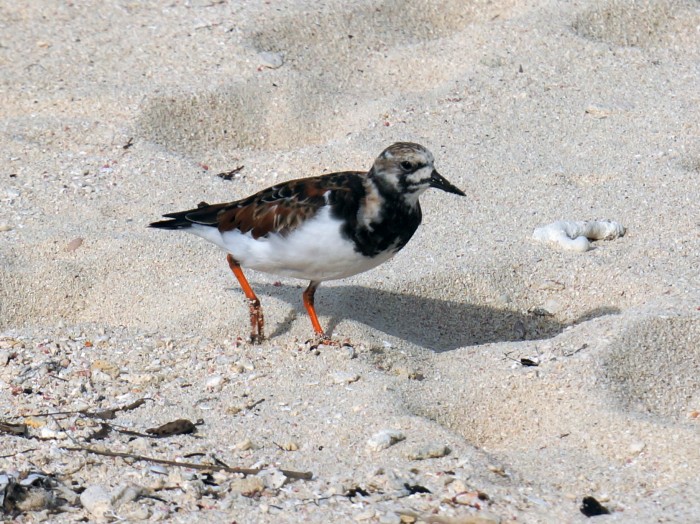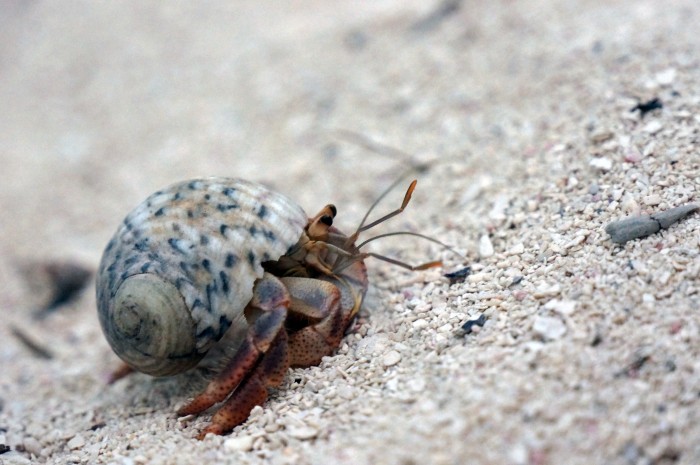On the road in Belize I: The Secretary’s Travel Journal
Join Secretary Clough as he journeys to Carrie Bow Cay Marine Station off the coast of Belize. From this tiny island, Smithsonian researchers study some of the most diverse and pristine marine environments in the world.

The Caribbean Coral Reef Ecosystems Program is a long term field site dedicated to investigations of coral reefs and associated ecosystems. Field operations are based at the Carrie Bow Cay Field Station on the Meso-American Barrier Reef in Belize. (Photo by R. Ritson-Williams)
Introduction
What is the connection between Mauna Kea in Hawaii; the South Pole; Mount Hopkins in Arizona; Saint Lawrence Island in the Bering Strait; the Las Campanas Observatory in Chile; Mpala, Kenya; tiny Worland, Wyoming; the Sacred Valley in Peru; Port Au Prince, Haiti; and Barro Colorado Island in Panama? The obvious answer is the Smithsonian−these are just a handful of the many places where scholars from the Smithsonian do field research that asks and answers fundamental questions about our planet. The less obvious answer is me. These are all places I have visited as Secretary to learn more about how the Smithsonian really works. But there is one last site that I need to visit in my last year as Secretary because of the role it will play in in a project I helped launch.
Carrie Bow Cay appears as a dot on a map off the southern coast of Belize, and is the only place where the Smithsonian has year-round physical facilities that I have not visited as Secretary. Although Carrie Bow Cay itself may be small, it is surrounded by one of the largest, most accessible, richest and least disturbed marine habitats in the world, a resource for our ocean scientists and hundreds of others from the United States and around the world. It will become even more important since it is slated to be one of the first five sites for our Tennenbaum Marine Observatories Network, a new form of global ocean observation platform that will allow scientists and policy makers to see with clarity the changes occurring in the ocean and how this happens over time. The Network will start with Smithsonian-controlled locations, including Carrie Bow Cay. Carrie Bow Cay is an ideal site for TMON because of its natural setting and because researchers working there over time have already established baselines as to species diversity and the overall marine environment. As the project moves forward, we will be working with partners such as the National Oceanic and Atmospheric Agency, Woods Hole Oceanographic Institution, universities and cooperating countries to develop other locations for the Network.
The agenda for our brief trip is packed in order for me to see as much of the science and preliminary TMON work on going at Carrie Bow Cay as possible. I am fortunate to be joined by Emmett Duffy, the director of the TMON project, and Valerie Paul, director of Carrie Bow Cay and our Fort Pierce Marine Laboratory in Florida as well as a key participant in the TMON. They can provide valuable insights into the project’s future plans and they are bringing along several post-doctoral students who are already working on different investigations that will contribute to the observations.
Before I return home, I plan to take advantage of being in Belize City to make a short side trip to Xunantunich, the site of a recently restored Mayan temple that is reachable by a two hour automobile drive. The Smithsonian has long pursued investigations aimed at understanding pre-Columbian cultures and my own interest was whetted by a visit I made to Peru in 2011 with colleagues from the National Museum of the American Indian, who will launch a major exhibition in 2015 on the Inka Road. More recently, I have been reviewing work the Smithsonian conducted over decades on Indian Mounds that are located in the southeastern United States. Extensive collections of artifacts obtained from the mounds are held at our Museum Support Center in Suitland, Maryland. New World native cultures have many things in common with each other, but each was unique as well. The Maya developed one of the most sophisticated of the New World cultures and much has been learned about these fascinating people in just the past few decades. My thanks to Jeremy Sablof, member of the Advisory Board of the National Museum of Natural History for helping to facilitate my visit to Xunantunich.
This trip will follow the pattern of my past visits to Smithsonian outposts, which have all been enlightening and inspiring. I met remarkable people, including Smithsonian researchers and staff as well as the people who live where our work is done. I have had conversations with the elders of the Yupic people of Alaska about how climate change was transforming their lives and with Peruvian descendants of the Inca in the village of Chawaytiri high above the Sacred Valley whose traditions are being preserved by Smithsonian researchers. These experiences have helped me to better communicate the work of the Smithsonian in the largest terms. After each trip I have written a journal to document my experiences and shared them with staff so they can appreciate just how seriously amazing the Smithsonian really is.
Traveling with me on this trip is Johnny Gibbons, the Smithsonian press officer for science and an ornithologist by training. He is also an outstanding amateur photographer. He contributed many of the images that illustrate this journal.
Carrie Bow Marine Field Station
April 10, 2014−Warm, breezy and partly cloudy
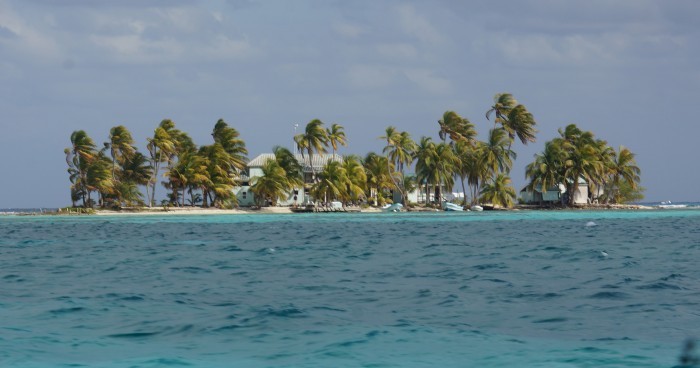
Carrie Bow Cay, off the coast of Belize, is only about 350 feet long and 120 feet wide. It has been the site of Smithsonian marine research facility since 1972 (Photo by John Gibbons)
Well before the marine station at Carrie Bow Cay existed, the Smithsonian was conducting active research in the Caribbean under the auspices of the Caribbean Coral Reef Ecosystems Program. In the late 1960s, CCRE researchers began to look for a site where a base could be established for long-term observations. The southern coast of Belize was ideal because of its relatively pristine conditions, high diversity of marine life and healthy coral reefs. A small island owned by Henry and Alice Bowman fit the bill and in 1972 the Smithsonian and the Bowmans struck a handshake agreement to allow the use of Carrie Bow as a base to study the rich and complex and marine environment of the region. Our relationship with the Bowmans has proven strong and durable, continuing with a new generation of the family.
Just a spit of land, Carrie Bow Cay is roughly 350 feet long by 120 feet wide and is graced by 60 or so coconut palms. You can see other islands nearby, some of which have been developed as low-key resorts. The developments presage change in this previously undisturbed area; our observational platform here will be crucial in documenting its impact.
The waters of the Caribbean are an artist’s palette of colors−green-blues dappled by cloud shadows are interrupted by patches of bright azure blue signaling the presence of shallow coral reefs. The water is in some places so shallow the reefs rise just above its surface, but less than a half mile out toward the ocean they drop precipitously to over 100 feet in depth. At Carrie Bow, the ocean-side reef, which is part of the great Mesoamerican barrier reef, rises to the surface about 200 yards offshore, creating a breakwater. The shallow calm waters behind it are patrolled by the pelicans and several small lemon sharks looking for snacks. This setting with its readily accessible shallow reefs, deep reefs, mangroves and sea grasses attracts both scientists and tourists alike.
Emmett, Johnny and I arrived at Belize International Airport around ten in the morning local time, April 10, accompanied by a planeload of excited tourists, spring-breakers and student groups. Both English and Spanish are spoken by the citizens of Belize, which at different times was once a colony of both Spain and Great Britain. As a further reflection of Belize’s accommodating nature, the good old U.S. greenback is accepted as a currency here.
Our journey to Carrie Bow still has two more legs to go, beginning with a 25-minute flight via Tropic Air in a small single-engine plane that took us to the coastal town of Dangriga. I was invited to ride in the shotgun seat next to our very polite (and very young) pilot. The plane skimmed down the coastline, passing over salt ponds and citrus groves that produce the fish and fruit for which Belize is well known today and that were also an important part of ancient Mayan culture. Our pilot lands skillfully on a short, narrow airstrip, where we are greeted at the small terminal building by a polite young man named Daniel. Daniel turns out to be the third generation of the Bowman family that owns Carrie Bow. In fact, before it was destroyed by a fire in 1997, the main laboratory on Carrie Bow was adapted from a home built by the Bowmans on the island.
We have lunch at a lovely one-story hacienda-like hotel, the Pelican Beach Resort, which is also owned by the Bowman family, where we will depart via boat for Carrie Bow. We are greeted at the hotel entrance by Alice Bowman—the same Alice Bowman who, with her husband, made the original agreement that allowed the Smithsonian access to Carrie Bow Cay. We also meet Alice’s daughter, Therese Bowman Rath, who tells us about yet another family connection to the Smithsonian. Therese is married to Mike Rath, who she met because Mike, who was born in Minnesota, was once the Smithsonian station manager for Carrie Bow Cay. Therese says with a laugh that she was in the right place at the right time when Mike came ashore after three months alone on the island and fell in love immediately. Today, Mike is a nature photographer of note and a part-time hotel operator. Our driver, Daniel Rath, is Mike and Therese’s son.
Over lunch, Therese shares stories of Smithsonian researchers she has known over the years; we also discuss the impact of climate change and local efforts to use sustainable practices as the pace of development grows. This area has been discovered by tourists and small resorts are popping up everywhere. Ominously, the big cruise lines are making plans to build massive ports and hotels that will flood this sensitive ecosystem with people. Therese is pleased the Smithsonian has been working here for more than 40 years to establish the special nature of this place so it can be protected.
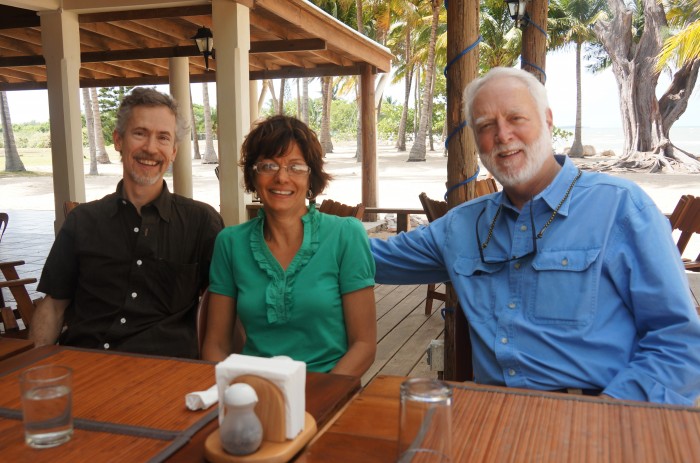
From left, Emmett Duffy, Therese Bowman Rath, Wayne Clough. Therese’s family has hosted Smithsonian researchers for more than 40 years. (Photo by John Gibbons)
After lunch, we head out for the 30-minute ride to Carrie Bow in a 25-foot open skiff named “Hangman.” Hangman is piloted by our skipper, the young and smiling Alvin, whose first mate is his brother Earl. Both are third-generation boatmen whose father, Junior, was the first in the family to begin piloting Smithsonian scientists, staff and visitors to Carrie Bow more than 40 years ago. Joining us on our sea voyage is Caitie Kuempel, a post doc who is on assignment from the Smithsonian Tropical Research Institute in Panama. We board the skiff and the outboard motor growls to life, powering us forward across the swells and waves. The ride is bumpy, but Alvin demonstrates the skills inherited from his father and grandfather as he angles the boat over the swells to minimize the sea spray, for which we are thankful. There is just enough spray over the gunnels and onto the passengers to make it feel as if we have had a boat ride we can write home about.
Along the way we pass many small islands and can see the tourist developments Therese had told us about. Most of the islands now have fairly low-impact resorts, but low-impact is not no-impact. The less developed islands are ringed by mangroves, which provide an ecological paradise for marine species and a buffer against storm surges. On the developed islands the mangroves have been cut to provide clear access and views. This not only eliminates habitat for marine species but also removes protection from beach erosion, a problem for which there are few solutions.

Frigate birds wheel above the rookery they have constructed in a stand of mangroves. (Photo by John Gibbons)
We pass a small island that is really just a stand of trees whose roots are supported by a dense mangrove mat. Above the island large birds wheel and circle while below, the limbs of the trees sag with the weight of roosting birds. This is a rookery for the frigate bird. Ranging from Mexico to Brazil, frigates are flying machines that are at once large, but also agile and fast. They fish by diving from a height and cruising just above the water’s surface to snatch a fish, but this often seems to be more trouble to them than it’s worth when they can resort to other means to obtain food. Johnny informs me that they are also known as the “pirate bird,” because when they see another sea bird catch a fish they use their top-gun flying skills to attack and harass the hapless hunter into giving up its meal. Frigates are so deft they can catch the falling quarry out of the air before it is lost to the sea. Here on this small tree stand in ocean, hundreds of frigate birds are raising their families. Joining them on the branches of some of the trees are brown boobies, another fish hunter who does real work, catching its quarry by diving from considerable heights directly into the sea. The brown boobies, even though they are sometimes the target of the frigate birds’ thievery, take advantage of the frigates’ protection by sharing their rookery. The rookery is a good example of symbiotic evolution: the presence of so many birds in one small spot leads to a large deposit of guano into the waters of the island, which in turn helps the island’s trees thrive.
In time, Alvin points out our destination, Carrie Bow. From a distance it looks tiny, and it is small in comparison to the other islands. Up close, it is still small but big enough to accommodate the work we do here. We arrive at about 3 p.m. Belize time, a bit damp but excited about the opportunity to be here.
The facilities on the island consist of the main house with the labs, kitchen, library and a few rooms for staff; a building with three guest rooms; a dorm with space for three people; a small machine room and a shower with two stalls. There is also a small pier on the ocean side of the island that terminates at two narrow shacks that are relics of an earlier day on the island before composting toilets arrived. This island privy is said to have toilets with the best view in the world.
- The Carrie Bow Club is very exclusive—it’s pretty far off the beaten path. (Photo by John Gibbons)
- Our accommodations. (Photo by John Gibbons)
- Emmett looks on as Zach, the station manager, begins his tour of the main lab facility and explains the island’s shoe-optional policy. (Photo by John Gibbons)
- Th erstwhile outhouses at the end of the pier. (Photo by John Gibbons)
The coconut palms help create the image of a tropical island that a travel agency would use to get the attention of a winter-weary denizen of some snowy urban center. But coconut palms are an invasive species, having made their way in distant history from the Pacific to the Atlantic. Other residents of the island include a family of 10 or so ruddy turnstones, a small bird that gets its name from its colors and its habit of turning over flat stones on the beach with its beak to look for food. These migratory birds would normally be found in northern climes by now, but this family has apparently concluded this idyllic island and its ample food sources beat the heck out of flying several thousand miles north in hopes of finding what they already have. Other occupants less visible and more likely to come out at night include a gaggle of hermit crabs that live under the porches of the main building. They swarm the food fragments that fall as meals are prepared and served. Their legs protruding from the shells they have appropriated, their numbers are a bit unnerving when they emerge, but they fortunately don’t win any speed contests.
After a quick tour of the labs, Johnny and I join Emmett, Val and Zach, the Carrie Bow station manager, to swim out to see some of the instrumented sites very near the shore of the island. I am not a great snorkeler, but get the hang of it enough to be able to watch Emmett and his post-doc, Solomon Chak, who arrived on the island a week ago, place a series of thin plastic rods in the seabed. The rods have bits of food attached to them to attract fish that will be monitored over time to track marine activity in the area. Nearby are sea grass plots laid out in a grid that will aid observations of changes in the grass and the creatures that live in it. From the shallow water near the island, we also can see coral reef just beyond the sea grass, and the tropical fish that make their home within and around the reef. They vary in size, color, shape and mode of locomotion and in my fascination, I am tempted to keep swimming further out from shore. I become somewhat of a pest by surfacing frequently to ask Emmett, Zach or Val, “What kind of fish is that?” They finally tell me to be patient because tomorrow we will visit reefs further out that will have many more varieties of fish and other creatures. With work done for today, we swim back into shore and clean up for dinner.
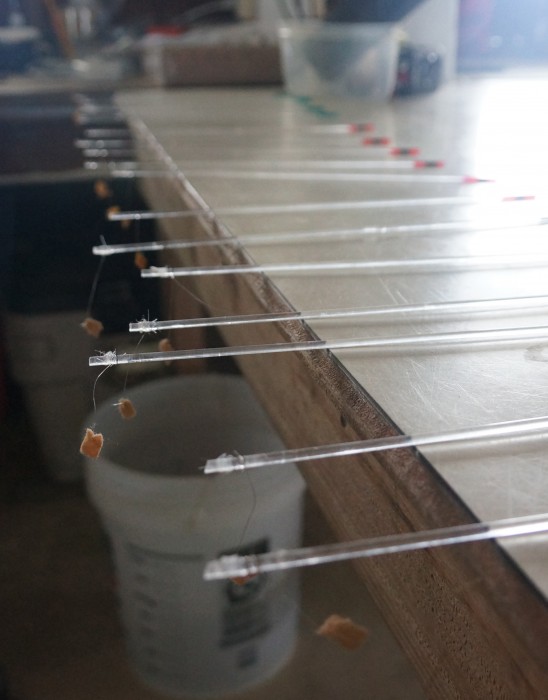
These baited plastic rods are placed in grids in the sea grass and will help scientists monitor marine life behavior over time. (Photo by John Gibbons)
Meals at Carrie Bow are a treat thanks to Martha Nicholas, a cook extraordinaire, who has worked there for more than 30 years. Martha is a small woman with an outsized ability to cook up a meal that is both delicious and nutritious and can satisfy even the most ravenous appetites of marine scientists who have spent all day on the ocean. This evening Martha has prepared coconut rice using coconuts from the Carrie Bow trees, beans that make a great rice topping, crispy fried fish and chopped salad. If this were not enough, she has also made orange pie, a variation on key lime pie that melts in your mouth.
We enjoy coffee and other libations while talking about our plans for tomorrow, which are ambitious. We will begin by visiting a shallow reef site where Emmett and Solomon can find specimens of snapping shrimp, a remarkable tiny shrimp that has a large claw that can be rapidly closed to make a very audible snap. These shrimp are social creatures like of ants or wolves in that they create family groups that work together to survive. They are found in colonies living in sponges. Very unusually for invertebrates, shrimp pairs raise families together and are possibly mated for life. We will also visit a mangrove swamp looking for the kinds of fish that habituate this vital ecosystem and finish the day with a trip out to the ocean where we will snorkel above the 100-foot drop-off of the reef system.
In Part Two, Secretary Clough ventures into the murky waters of a mangrove swamp, a critical part of the marine ecosystem. >>
Posted: 7 May 2014
